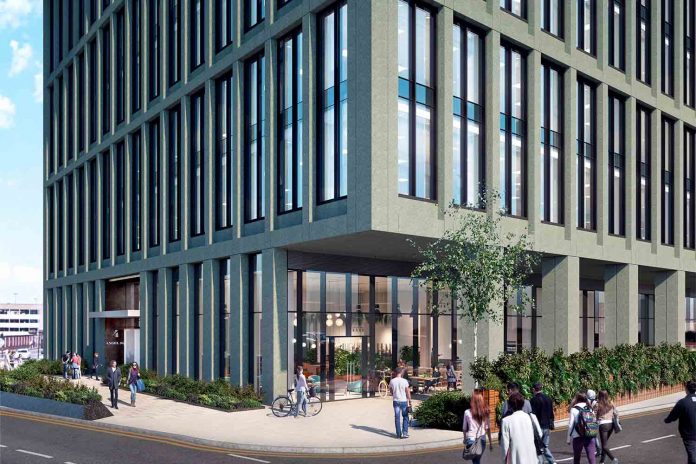Jim Saywell, director of UK sustainability and physics at Buro Happold and member of the NABERS UK Design Review Panel, explores the NABERS energy rating system and how schemes like this can help office owners and operators close the performance gap, bringing benefits to people, planet and budgets
Energy use in office buildings is often much higher than estimated at the design stage. The average office building uses almost four times more energy than calculated in the design stage.
This is a glaring difference and often achieving the full potential of buildings in the real world is an ongoing challenge for projects.
It’s vital that the built environment acknowledges this challenge as buildings need to be greener and more efficient to achieve important net zero targets. To solve this, it’s critical that projects continue to consider efficiency beyond the design stage and are carefully assessed in operation.
This isn’t done in many offices, however, resulting in buildings simply not being operated in the intended or expected way.
It’s equivalent to driving on the motorway in third gear, expecting to get your car’s advertised miles per gallon. We’re all aware of what’s wrong in this example, but when it comes to operating a building it’s less immediately obvious when a space isn’t working in the most efficient way. This means inefficiencies can be missed or not spotted for some time.
The key to addressing this problem is to accurately and consistently measure operational energy efficiency. With a rigorous and regular assessment process in place, we can understand exactly where and how buildings are wasting energy, and how their systems can be fine-tuned to achieve the potential set out in the original design.
Assessment schemes such as NABERS can really help
NABERS is the mandatory model for measuring commercial energy efficiency in Australia. It requires an annual assessment of a building’s energy use when in operation, formalising a process that’s key to making sure buildings achieve their full potential.
The scheme has a UK counterpart, called NABERS UK administered by BRE. It’s a good example of a programme that gives developers and operators a framework to understand building efficiency more accurately, right through design and into operation.
There is currently no requirement for buildings to accurately monitor energy efficiency. For a new building, it could be as many as four years before an Energy Saving Opportunity Scheme (ESOS) building audit is required. While the ESOS is a useful process and mandates a real-world performance assessment, waiting four years for an efficiency report is a long time.
Regular and accurate reporting is essential to closing the performance gap, and developers and operators should act and undertake more regular assessments.
NABERS UK can help do this, allowing new office buildings to target a recognised energy rating by using something called the Design for Performance process.
On top of providing this effective framework, an important byproduct of regular assessment cycles is that we, as a sector, create a cultural shift away from box-ticking and regulation compliance towards a model that informs and incentivises owners and operators to improve how they manage their facilities.
Putting these new processes in place won’t happen overnight, however. In Australia, NABERS took 10 years to be fully adopted by the building industry, and the results have been impressive. If we are serious about replicating this success in the UK, we must start now.
What does the NABERS process look like?
The steps to improving energy efficiency begin at the design phase. An energy model built around how the building will actually operate is critical, as well as communicating targets to the project team about what needs to be achieved.
At the design stage, an independent design review takes place. This forms part of the design for performance process, aimed at ensuring a building can meet target energy ratings. Then once occupied for 12 months, a further review is undertaken to assess how the building is operating.
At this stage, being transparent about current energy consumption is key. With this understood, you can begin to take informed decisions on practical steps to improve efficiency and close any performance gaps.
A reoccurring but often overlooked challenge is the skillset needed to run modern, technology-filled offices. Estates teams must be trained to use building management systems (BMS) effectively. This is often not recognised but is a vital step towards improving efficiency. Developers should be aware that smart building systems are only worth installing if you invest in the skills needed to operate them correctly.
With the right design decisions, effective real-world monitoring and skilled estates teams, it’s absolutely possible to close performance gaps and make sure buildings work as intended.
The benefits of implementing NABERS
The benefits of moving to a performance-based scheme are significant. Australian offices rated using NABERS have benefitted from average energy savings of 42% and have reduced greenhouse gas emissions intensity by 53%.
And the benefits aren’t just monetary or environmental. Creating effective monitoring systems presents an opportunity to identify and adjust how buildings are working to also enhance occupants’ health, wellbeing and productivity.
How to achieve net zero
The benefits of closing the performance gap aren’t just linked to buildings either; they also belong to a broader culture shift required to reach net zero.
Achieving net zero is a massive challenge and transitioning to green energy sources is essential. Yet, the focus largely remains on the supply side of the equation. There is no doubt that building more renewable energy sources is incredibly important. However, if we can reduce energy demand in tandem this will only accelerate progress toward green targets.
The NABERS system example, aimed at lowering the energy demand of commercial property, combined with other schemes to support efficiency savings in residential property, can contribute significantly to lowering overall energy demand right across our building stock.
Ultimately, if we want to reach net zero, improving energy efficiency across the board is critical. My recommendation to the commercial office sector is to – if you’re not already – take the initiative and assess how efficient your buildings actually are. With this intelligence, you can quickly identify where any performance gaps may be and take targeted action to help ease pressure on budgets and create greener, better places.
Jim Saywell
Director of UK sustainability and physics

Buro Happold
Tel: +44 (0)1225 320 600














